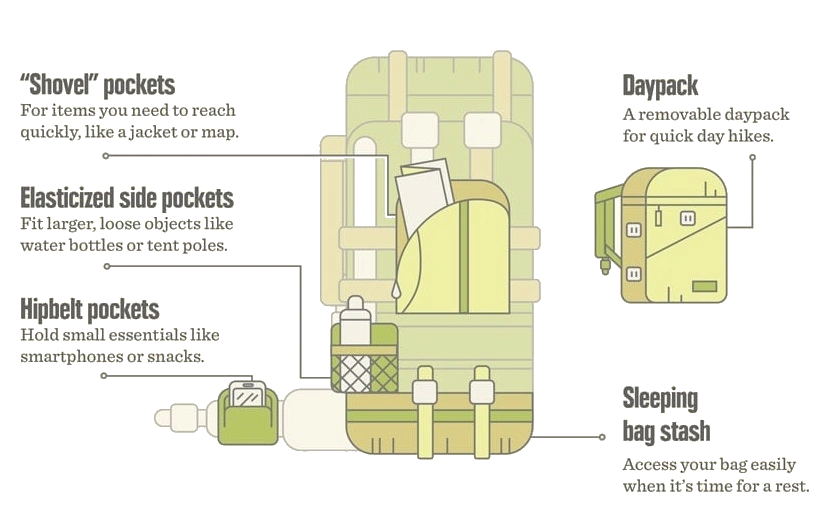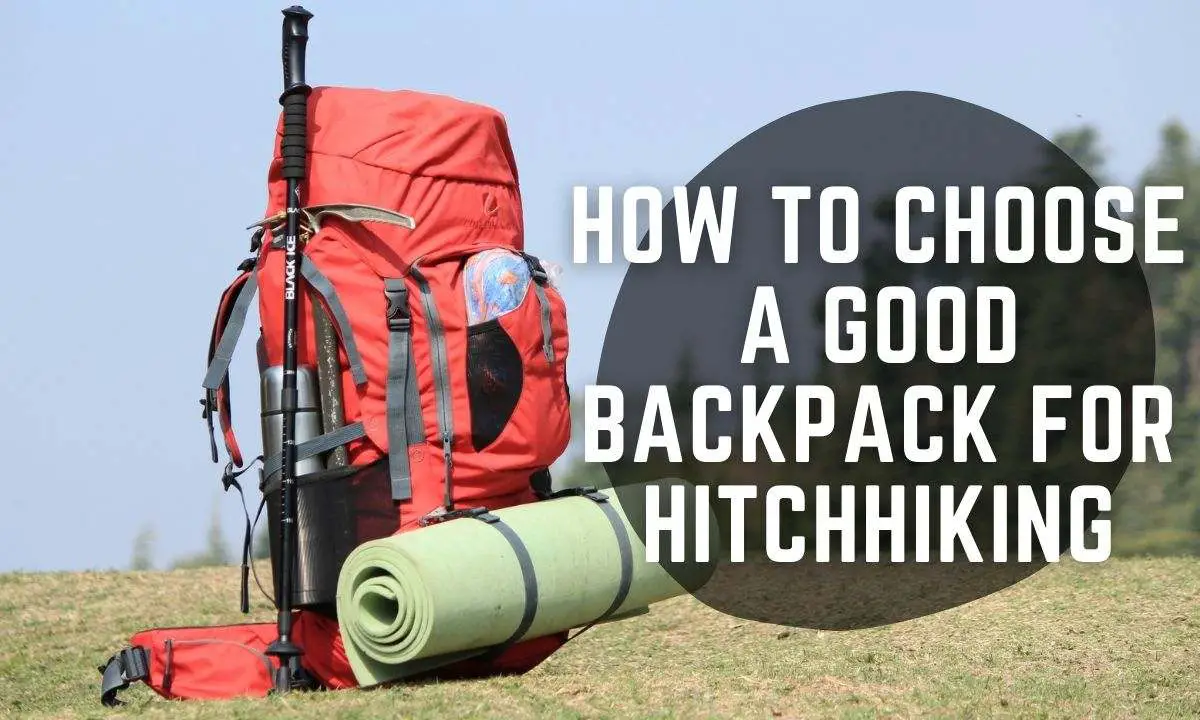A backpack can make all the difference between a delightful and a disastrous hitchhiking experience.
So, it comes as no surprise how important it is to choose a good backpack for an enjoyable hitchhiking experience.
Choosing a good backpack can be confusing, especially if you are a beginner. There are hundreds of alternatives and features to choose from, which further leaves you bewildered.
But don’t worry, based on our experience as hitchhikers on the road, here’s our guide that answers the age-old question nagging every wanderlust, How to Choose a Good Backpack for Hitchhiking?
So, roll up your sleeves and dive right into it.
Here’s a Guide on How to Choose a Good Backpack for Hitchhiking?
Table of Contents
Why is it important to choose a good backpack for hitchhiking?
Hitchhiking is to travel on a tight budget, but that doesn’t mean that you also cut down on the most important things that you need.
A good backpack doesn’t come cheap. So if you are going to spend some bucks on your backpack, then it better be damn good.
Another thing to consider is when hitchhiking you are going to spend most of your time walking on the road, standing at gas stations, highway entry/exit points putting your thumb out to hitch a ride. This means that your backpack is going to be on your back for a while.
Be it an intense downpour or beautiful sunny weather, your backpack needs to do what it does best- i.e. carry and protect your things from the outside. At the same time, you mustn’t be left with a sore back after all your time on the road.
Once you understand how important buying a good backpack is, the next step is to look for features that make a backpack suitable for hitchhiking.
What makes a good backpack?

Light-weight
I cannot stress enough how important the weight of a backpack is especially when it comes to hitchhiking.
Carry a backpack that is too big, and you will often find yourself carrying things you don’t want just to fill up space. Similarly, carrying a small backpack might make you cut down on stuff that you really need.
Larger size backpacks lead to weight shifting more on your shoulders and pulling you down, while the smaller ones can put a noticeable strain on your waist.
When choosing a backpack make sure what material it is made of.
For ex: most lightweight backpacks are made of Ripstop Nylon or Dyneema Composite Fabric (Cuban fibre). Backpacks made from both these materials are durable and highly functional in rough weather conditions.
Comfort
One thing that you shouldn’t compromise on while buying a backpack is your comfort.
Whether you are hitchhiking or not, you will be carrying your backpack everywhere. So make sure your backpack is comfortable to carry around by tossing some stuff into it.
Backpacks with breathable padded shoulder straps and padded waist straps ensure that the load is evenly distributed throughout your upper body making it easier to carry for long distances.
Water-Resistant
Water-resistant backpacks are a must when it comes to hitchhiking. Some water-resistant backpacks prevent the water from seeping inside but soak the water on the exterior fabric adding to the weight of the backpack.
Many backpacks come with a tarp (rain cover) to protect your backpack from a heavy downpour. No backpack is 100% water-resistant as one would expect, water can seep inside your backpack through seams and small gaps between zippers.
I am personally a huge fan of backpacks that come with a raincover. Raincovers are a lifesaver when you experience a sudden drizzle along your journey.
Backpacks made with materials like Rip-stop nylon and DCF are relatively expensive compared to other fabrics but are super-efficient in resisting water from seeping inside your backpack. I use an REI 60L backpack made with Rip-stop nylon and I’ve never opened my bag to find wet clothes after a normal downpour.
Lockable Zippers
Lockable zippers are a big lifesaver. They prevent your things from theft or accidentally falling out of your backpack.
Backpacks come with compartments having two zippers, except for the single zipper side compartment. Now, it’s an obvious thing that you will carry your most essential items like clothes, gears or gadgets in bigger compartments, but it also makes it difficult to grab them at your will.
I always like to keep my gadgets like a go-pro or a camera handy, which I keep in the smaller outer compartments. Keeping things in the outer compartments with a single zipper is a bit risky. There are chances of rainwater seeping in through the zippers, things falling or getting stolen.
To make sure your things are intact inside your backpack you can buy TSA-friendly locks. TSA-friendly locks are super-easy to use and can be opened easily with a release valve without breaking the lock.
Multiple compartments

When you are travelling it’s always better to compartmentalize your things into different sections. Your clothes and essential wears in the main compartment, your gears in the upper side compartments and other stuff in the lower outer compartments.
When choosing a backpack, always go for one with a minimum of 4 outer compartments i.e. small top compartment at the top, a little bigger compartment at the centre and the two compartments on the side.
This way you won’t find it tiresome to keep your stuff organized throughout your hitchhiking journey.
Internal Body Frame structure
Backpacks come with three body frame structures, mainly
- Internal-frame structure
- External-frame structure
- Frameless structure
Internal-frame structure – A majority of backpacks used today for hiking or backpacking have an internal-frame structure. In an internal-frame structure backpack, the support frame and rods are hidden inside the fabric of the backpack along the perimeter.
Internal frame backpacks provide a more custom fit and distribute the load better on your hips which allows you to carry loads for a longer period.
External-frame structure– As the name suggests, has the support and load distribution rod located externally. As the frame is outside the bag, it provides more ventilation.
External backpacks are good for carrying very heavy loads. It is especially used by photographers a lot as it allows some space for a few extra gears to toss in it.
Frameless structure– Ultralight backpacks without support frame for short expeditions.
Now, that you know the types of frame structures backpacks come in, you might guess why you should go for internal-frame backpacks?
The adaptability and comfort fit of the internal-frame backpack makes it the best option for hitchhiking. I have always used an internal-frame backpack on all my hitchhiking expeditions and found them to extremely adaptable to my body size.
I seriously don’t understand why some choose to go for an external-frame backpack unless you are a photographer or on a road trip carrying heavy gears and stuff. If you are one, then definitely go for one, if not stick with an internal-frame backpack.
Front Panel-loading
Backpacks come with two types of panel loading i.e. the most commonly used top-loading and the other is front-loading. Although every backpack has an opening at the top for loading your essentials into it, an opening for loading things from the front comes in very handy when you are constantly on the go.
With a zip to open the face of the backpack from the front, I can easily grab any swim-wears or shorts without having to take out the whole stuff from the top until I find the stuff I am looking for.
So, Yeah! Grab one that can be loaded/unloaded from the front.
Padded Shoulder Straps
Padded shoulder straps make it comfortable to carry a heavy load for a long time distributing it evenly along your shoulders and upper body.
Padded Waist/ Hip Belt
A padded waist/hip belt distributes the weight of your backpack evenly throughout your lower body.
Most backpacks today come in various hip belt sizes ranging from 25inches to 40 inches. You have the option to go for a backpack with interchangeable hip belts if you find the default one uncomfortable.
How do I choose the right backpack size for hitchhiking?
Choosing the right backpack size boils down to your body size and the weight you are going to carry on your hitchhiking journey.
A good practice before choosing a backpack is to measure the length starting from your shoulder line to the tip of your hip bone.
Depending on your torso length you can choose the right backpack that is the right fit for your body type and the load you will be carrying.
| Pack Size | Torso Length |
|---|---|
| Extra small | Upto 15+ |
| Small | 16″ to 17″ |
| Medium | 18″ to 19″ |
| Large | 20+” |
What size do backpacks come in?
The size of the backpacks is determined in litres i.e. 40L, 60L, 70L and so on. Depending on the type of activity, utility and body types, backpacks come in 3 size categories.
30-50L – These are lightweight backpacks for travel enthusiasts carrying minimal gears and clothing. These backpacks are best suitable for travellers who are looking to spend a day or two hitching or camping in the mountains.
50L-80L – These are the most commonly used backpacks used by most travellers and pro hitchhikers. Enough space to toss in some extra stuff for a long hitchhiking expedition.
These backpacks are also built to handle extreme weather conditions making them a reliable option in places where the weather is quite unreliable.
70L-80L – These backpacks are made to carry heavy loads, especially suitable if you are travelling with your family (with kids). These backpacks can accommodate a small size sleeping bag and a small 4 season tent if you looking to spend your nights camping outside.
I personally use a 60L backpack which I have found to be perfect for size and my needs. I can easily fit all my clothes, gears, gadgets and documents and still have some extra space left to toss something in it.
Bottom Line
The last thing that I would say on choosing a good backpack for hitchhiking is “Don’t overdo it”. Take your time researching and trying on some backpacks by tossing some weight into them to get the right feel for it before you buy one.
Considering you are mostly going to hitchhike, going for a large size backpack of 70L or 80L doesn’t make any sense. You don’t want to carry the extra load of the backpack on your shoulders and travel with a huge bump coming out behind your head. So, stick with 50L-70L backpacks, they are more than enough for anybody on a hitchhiking journey.
***
I hope you find this article helpful. If you think there’s anything we should add, please feel free to write to us in the comment section below.
